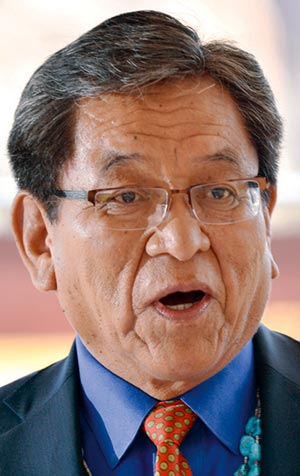
Begaye highlights effects of spill during state of the nation

Russell Begaye

Russell Begaye
Just three months after Navajo President Russell Begaye took office, a rupture at Colorado’s Gold King Mine sent 3 million gallons of toxic wastewater downstream, leading to one of the Navajo Nation’s biggest environmental emergencies in recent history.
Begaye, along with other Navajo officials, testified about the spill last month during a series of Congressional hearings called to investigate the causes, estimated damages and plans to clean the Animas and San Juan rivers and keep similar spills from happening in the future. The Aug. 5 spill, for which the U.S. Environmental Protection Agency has taken full responsibility, also was one of the main topics in Begaye’s State of the Nation address, which he delivered Monday to the Navajo Nation Council.
“The impact of the Gold King Mine spill on the financial, emotional and spiritual livelihood of our Navajo people has been detrimental,” he said. “The San Juan River is critical to the Navajo farmers and ranchers that depend upon the river to sustain themselves.”
The mustard-colored plume of toxic waste traveled from the Gold King Mine, an abandoned gold mine near Silverton, Colo., that has been inactive since 1923, into the Animas River. The plume reached the confluence of the Animas and San Juan rivers on Aug. 8 and Lake Powell on Aug. 12, Begaye said. In his address Monday, he said resources were delivered to 14 Navajo chapters and donations came in from across the country.
Although the Navajo Nation is suing the EPA, the relationship between the two remains cordial, Begaye said. Since the congressional hearings, the EPA has been more responsive to the needs of the Navajo people, and the Nation has participated in conversions with the EPA about long-range cleanup plans and claims processes for ranchers and farmers.
“We are both very interested in reaching an agreement that benefits the Navajo Nation and our Navajo people,” he said.
In her report to the Council, Sharon Pinto, regional director of the Bureau of Indian Affairs’ Navajo Regional Office, said the BIA spent $1.2 million to provide water and livestock feed to communities affected by the spill. The agency also is continuing to test river water and sediment to determine long-term effects of the toxins.
“It was huge, and it’ll continue to remain a large impact to (residents’) livelihoods,” Pinto said of the spill.
Congress will hold a follow-up hearing sponsored by Arizona Sen. John McCain in February.
During his address, which he shared with Vice President Jonathan Nez, Begaye also touched on several vulnerable populations, including youth, elders and veterans. He highlighted efforts under way to curb the recent wave of suicides, calling on the Navajo Nation Division of Health and the Indian Health Service to build an inter-disciplinary team to address the “solemn and heart-wrenching issue.”
“One of the things we’ve been advocating throughout the Navajo Nation is that we need to empower our youth,” Nez said. “We want to challenge our families out there to get back to sitting at the table and having a meal together so we can have some cross-disciplinary, intergenerational teaching.”
Begaye said his administration is prioritizing veterans. All divisions will be responsible for addressing issues of housing, employment, health care and mental health, he said.
“Our Navajo veterans have served as protectors of the United States and the Navajo Nation,” he said. “It’s our duty to honor their service.”
As such, Begaye said his administration will focus on passing the Navajo Nation Veterans Act, creating a regional Veterans Administration service center and establishing a Navajo Code Talker Museum.
Finally, the president and vice president announced that three newly appointed division directors would seek confirmation from the Council this week: Donald Benn as director of the Navajo Nation Environmental Protection Agency, Bidtah Becker as executive director of the Division of Natural Resources and Terrelene G. Massey as executive director of the Division of Social Services.
Vacancies remain for the position of the controller and executive directors of the Division of Economic Development, the Division of Community Development and the Department of Health.
To read the full article, pick up your copy of the Navajo Times at your nearest newsstand Thursday mornings!
Are you a digital subscriber? Read the most recent three weeks of stories by logging in to your online account.







 Highway 264,
Highway 264, I-40, WB @ Winslow
I-40, WB @ Winslow